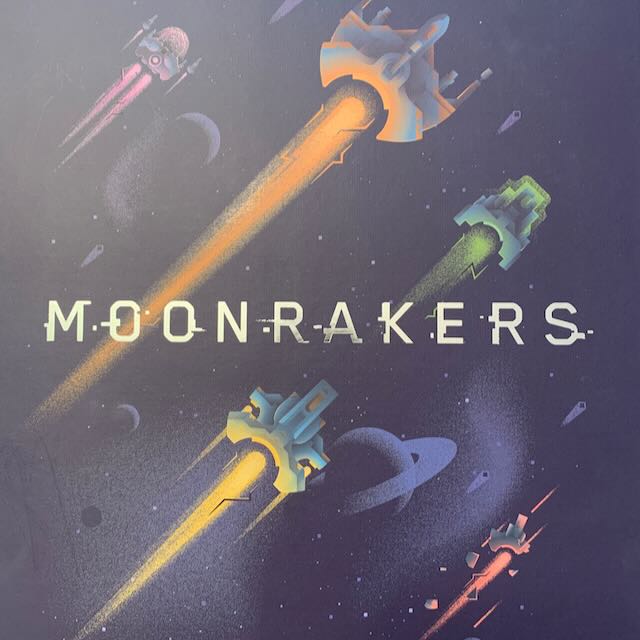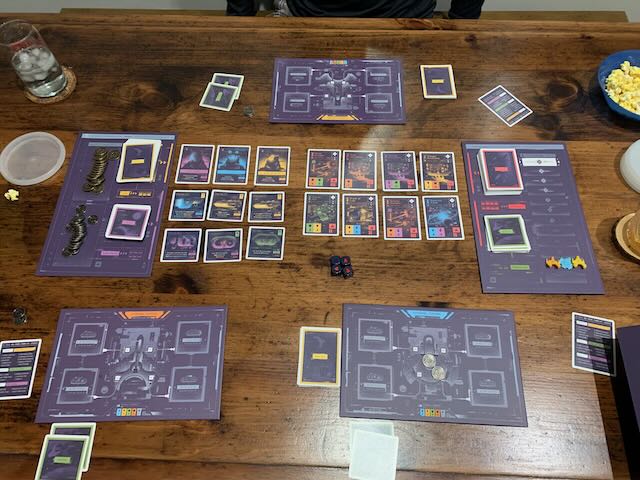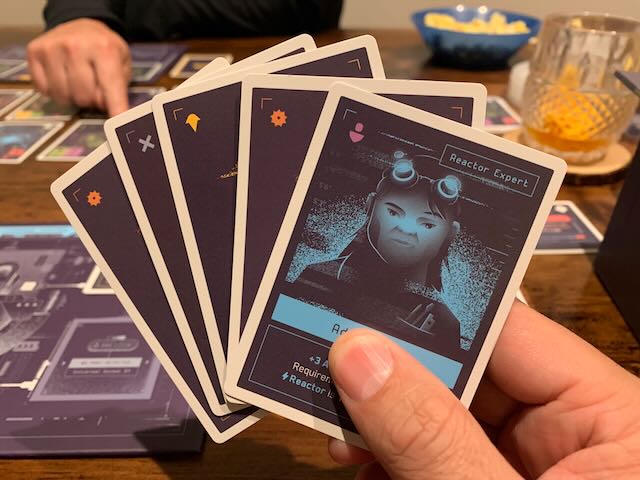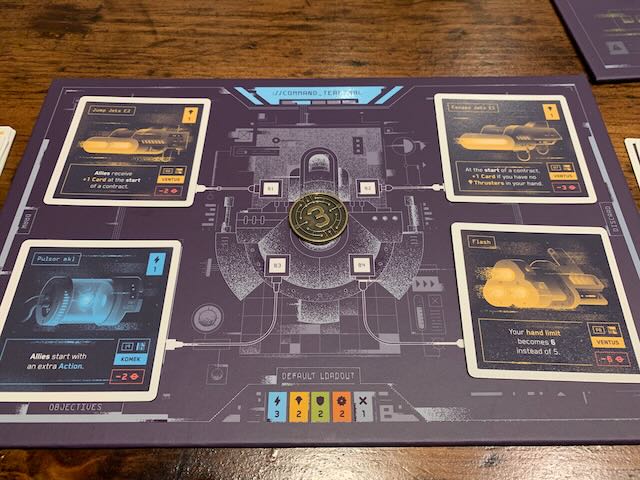
I have been on a bit of a sci-fi kick with the games that I have been playing lately. So when my copy of Moonrakers arrived from IV Games I was stoked to get it to the table and give it a spin. I mean, come on, that box art is sick!
*IV Games was gracious enough to provide a copy of Moonrakers in exchange for an honest review.
Moonrakers Overview
Moonrakers, designed by Austin Harrison, Max Anderson, and Zac Dixon and published by IV Games, is a deck building / negotiation game for 1-5 players. In Moonrakers, players will be competing for prestige and money to become the most legendary space mercenary in the galaxy. The first player to achieve 10 prestige points is declared the winner. But victory cannot be achieved by going it alone. In order to be successful in Moonrakers it is going to take some teaming up and shrewd negotiation with your opponents.
Set Up
The set up of Moonrakers is not overly difficult. The dispatch and armory boards are placed on the table and the respective ship part, crew, objective, and contract cards are placed on each board in the allotted spaces. 8 contract cards are revealed in 2 rows of 4. Be sure to return any contract that has a hazard greater than 2 to the contract deck and draw a new one until all 8 displayed contracts have a hazard value of 2 or less. Ship parts are laid out in 2 rows of 3 cards and crew cards are laid out in a single row of 3. The credit coins are placed in the allotted area on the board.
Players will then each take a ship board, corresponding ship token, and 2 – 1 credit coins. Each player also draws 3 objective cards, selects 2, and places the card that was not selected at the bottom of the objective card pile. Then players place their ship token on the zero spot of the prestige track. Last but not least, players will take the cards that are used for their starting deck. This deck consists of:
- 2 – single damage cards
- 3 – reactor cards
- 2 – shield cards
- 2 – thruster cards
- 1 – miss card
Players shuffle these cards and draw 5 to form their hand and that’s the set up. I am going to be honest, when we set the game up for the first time I was surprised how much table space the game took up between the market cards and the player boards. Thankfully, the components are super premium and it really does look cool on the table.

Gameplay
A round of Moonrakers consists of several phases and starts with the mission leader for that round. The mission leader will first make a choice between trying for one of the 8 contracts available or staying at home base for the round. If the mission leader decides to stay at home base, they will be able to draw objective cards (keeping one) and collect 1 credit. They will also have the option of replacing one of the contract cards on the table and must discard their hand and draw 5 new cards. This is a nice reward for essentially passing on your turn and sometimes that is the only play. But the game really gets going if the mission leader decides to take on a contract.
Contract cards all have requirements and rewards. Requirements to meet the contract are at the bottom left of the card. This is typically a combination of Thrusters, Damage, Shields, Reactors, and Crew cards. Rewards are at the top right. There is also a hazard level on the bottom left that determines how many hazard dice must be rolled to start the contract. Once the mission leader has selected one of the 8 contract cards then the negotiation begins . . . or not.
You Scratch My Back . . .
There may be a chance that the mission leader may have all the cards they need in their hand to take on the contract solo. Most likely that is not the case and they will need some help. The mission leader will then invite other players in on the contract with them in exchange for some of the reward of the contract. The rewards and the level of involvement are negotiated, including who rolls the hazard dice and the mission begins.
Mission Control
At the start of the mission the players selected roll the hazard dice. These dice represent damage that the player could take on the mission if they are not defended with shields. Each hazard that remains at the end that was not defended will cost the player 1 prestige point, regardless of mission success or failure.
During the mission, players will take turns playing cards from their hand to fulfill the requirements of the contract. The catch here is that players can only play a single card for the mission unless they play cards that give them additional actions. Careful preparation and lots of trust is needed during negotiation to plan for a successful mission.
If the mission succeeds, the rewards are split amongst the players as negotiated. Players that participated in the mission discard the remaining cards in their hand and draw 5 new cards from their draw pile. If the mission fails, no rewards are distributed and players that participated discard their hand and draw 5 new cards.
Upgrading Ship and Crew
Now it is back to the mission leader to hopefully spend the fruits of their labor. They are able to now purchase cards from the market. All of these cards are unique and have unique effects:
- Crew Cards – These cards go into your deck and are used for fulfilling contracts and have unique abilities when played.
- Ship Part Cards – These cards are slotted onto your ship. They will typically give you a player card (damage, shield, etc . . ) and offer a permanent buff while the part is on your ship.
Buying cards can be done by the mission leader whether they went on a contract or if if they stayed at base for the round. Once they have completed buying, they then draw 5 cards into their hand. The person to their left becomes the mission leader and the next round starts. The rounds will continue until one player has reached 10 prestige points.
Moonrakers Game Impressions
Components

You didn’t think I would drop the “premium components” comment above without actually talking about them did you? The components for this game are outstanding. Metal coins! Very few games offer metal coins as a standard component. Cardstock is really good quality and the artwork is has a cool sci-fi digital look. Text is a bit small but that is not a dealbreaker. Player prestige trackers are molded ships. They could have easily used colored cubes here but the extra attention is appreciated. However it is the game boards that stand out to me. Not only are they high quality and the layout is intuitive but the player ship and common boards have like this metallic foil inlay. If the boards (and the box) catch the light just right they seem to shimmer, totally cool! By far the best components I have seen in a “standard” version of a game.
Gameplay Impressions
Moonrakers is a solid game. I don’t think I have seen the combination of deck building and negotiation in a game before and I think it works well. I also really like the ship upgrade feature of the game. Some upgrades were really cool and incentivized people to include you on contracts because of the buff you bring to the team. Negotiation games are always kind of hit or miss and really depend on the crowd you have at the table. I liked the negotiation in the game and it felt like there was a nice balance of known vs. hidden information. I thought there would be more bluffing and backstabbing going on but that could just be due the the players at the table.
The deck building is well done and the cards you get have you playing out a nice puzzle in your head to see if you can lead or contribute to a contract. Building your deck is like customizing your load out. One game, one of our players built a tank load out that could mitigate all sorts of damage, a very valuable ally on high hazard missions. The ship customization is super cool and I kind of hope this makes its way into more deck building games.

Some Critiques on Moonrakers
I did have a couple of detractors on the game. First, it did feel like the game went on for a bit too long. I think this is due to a bit of pile on the leader syndrome. People were less inclined to go in on contracts or negotiate with the current leader as they got closer to 10 points. The hidden objective cards are supposed to help push a leader to get those one or 2 needed prestige points for victory, but that seemed to be the exception in our games.
The second was the fight over prestige points. Because they are the win condition everyone wanted prestige points in contracts. So much so, that if they were not getting them they were not inclined to go in on a contract. Lots of negotiations fell through over prestige points. Again this may just be the folks I play with.
I will say that the game has grown on me after multiple plays. Our first go around we did get a couple of key rules incorrect. Specifically the action tree. Subsequent play throughs with my family with the correct rules helped smooth the game out. But my 2 detractors still remained.
Final Verdict on Moonrakers

This game is soooo close to being a 4 star game for me. I think if IV Games can find a way to incentivize more negotiations and pick up the pace this will be a winner. The deck building is well done and the components are outstanding. IV Games does have an upcoming kickstarter expansion for the game and it will definitely be on my radar to check out what they have in store for Moonrakers.






Leave a Comment